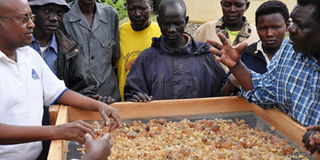Traders flood Karamoja for gum arabic

Farmers at a training in Moroto on how to distinguish between good and bad gum arabic. Photo by Steven Ariong.
What you need to know:
An often neglected tree in Karamoja, which also faces destruction by human activities, holds the key for the improvement of people’s lives.
Gum Arabic, a natural product from a type of Acacia tree that is common in Karamoja and usually ignored by the locals could become an alternative source of livelihood.
This follows the presence of foreign traders and companies, who have opened shop in the region and are buying large quantities of the gum.
In addition to this, they are carrying out programmes or supporting initiatives to train the inhabitants on how to harvest, pack, and sort gum Arabic. One of these is Kenyan Assal Resource Agency Ltd.
Wider market
Mr Abdi Somo, the company’s chairperson, who is overseeing the trainings through Uganda Gum Arabic Cooperative Society, says Karamoja has a lot of gum Arabic but the people are not aware that it could improve their livelihoods.
“If the Karimojong could harvest the gum Arabic, I can assure you that nobody in Karamoja will cry of hunger,” he claims.
Grace Nachap, a mother of six children and a resident of Kautakou village in Napak District, is excited about the wider market for the gum.
Training
“I have been collecting the gum for about three years and selling it to the cooperative. The money that I get is used to pay school fees for my children and to feed them,” she says.
Mr Jimmy Lomokol, chairperson of the cooperative society, adds that there are more than 600 women and men who have undergone the training on how to harvest, pack and sort the gum.
The cooperative society was formed in 2002 and current membership stands at 2,000. It buys the gum from the harvesters at Shs1,700 per kilogramme and sells to traders and companies at $1.30 (Shs2,552) per kilogramme.
Prices
But this price is only from traders who are from within East Africa. But for those from beyond East Africa, the price from $2.30 (Shs5,798) to $3.70 (Shs9,328) per kilogramme.
“It is an exported product only that it lacks funding from government to enable the cooperative to boost local production,” he said.
The foreign companies that have developed an interest in the gum Arabic include Hill Group Company, from Ireland, SNI Company which is based in France, and others from China, Thailand and India.
Challenges
According to Lomokol, there are several challenges that affect the production of gum Arabic in Karamoja.
Deforestation is a major one as over the last 10 years, many Acacia trees had been cut down by the local communities to make charcoal and for the constructions of settlements.
The other is climate change. In the past five years, the rainfall in Karamoja has reduced from an average of 1,000mm to 600mm while the humidity has increased from 35 to 65 degrees. This is not favourable for the production of gum Arabic.
High hopes
“For the trees to release the gum they must be stressed by hot weather, which needs to be about 31 degrees for the period of 21 days and humidity should be bellow 40 degrees. There should also be enough wind so that the trees to rub against each other to create way for the gum to come out,” Lokomol adds.
The rampant bush burning in the area is yet another one. Many trees are burnt by the inhabitants in hunting expeditions.
In addition to this, are the occasional incidents of insecurity, which hinder the people from going into the bush to collect the gum.
But with commercial potential of this indigenous resource, hopes remain high for larger quantities gathered, better prices for the product and, in turn, improved incomes and well being for the people.




